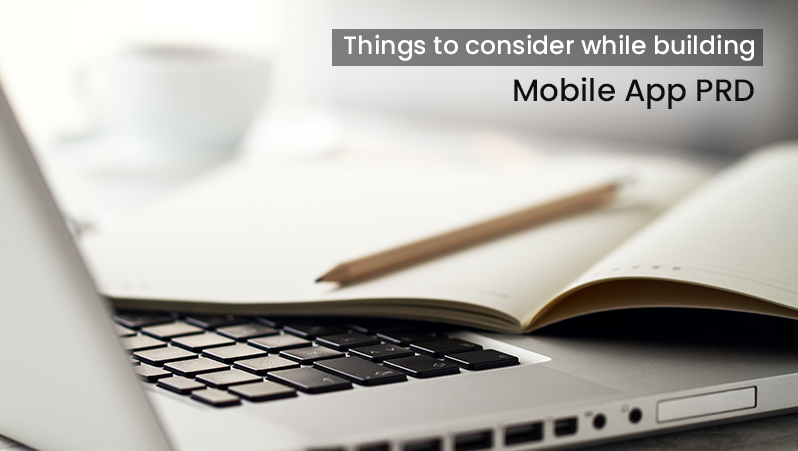Understanding the purpose of Mobile App Requirements Document:
Mobile App Requirements Document or product requirement document (PRD) is designed with the core objective to elaborate your requirements and expectations from the developers regarding the app. This sets the focus straight to the outcome. This ensures that the project is discussed in detail with all of its technical requirements, potential risk areas and challenging product assumptions.Key things to consider
Here is a list of key points you need to consider while approaching the Format of Mobile App Requirements Document:- Describe your app idea in general- a brief intro
- Incorporate user stories
- Enlist all must-have features you are aiming at
- List out data capturing and generation preferences
- Explain potential gateways (in case you plan to monetize the app)
- Prepare rough sketches & wireframes
- Detailed timeline of the launch plan
Let us understand in detail
-
Describe your app idea in general- a brief intro
Being with writing the final outcome of the project. What the app wants to achieve and how it aims to meet requirements of the end users. Mention the key features of the application. For example, Swiggy is the app that deliver food to the users from their favorite restaurants. Your brief should address following questions:- Who is my target group of audience?
- Why do the TG need my product?
- What problems will this product/app solve for the users?
-
Incorporate user stories
User stories are a great way to express your expectations from the app. By clearly studying the navigation patterns that users of successful apps follow, you can explain more about functionality and design aspects of the app to the developers. Begin with description of opening steps of the app such as onboarding & registration, followed by home screen user experience and overall user journey. Remember to enlist all the key factors including “forgot password” feature, privacy policy and more. -
Enlist all must-have features you are aiming at
Develop a simple framework, where you list the details of your features in two categories – Must haves and Good to have (not mandatory) features. When you are drafting the Format for Mobile App Requirements, begin with highlighting the core features to be integrated in the app. Along with that, mention the list of screens, followed by quick description about each of the screens. It is wiser to explain these requirements in sequence for the developers to understand it better and work accordingly. -
List out data capturing and generation preferences
If your app is database oriented, you must explain about all the data points you want to capture for gathering user information. For example, an ecommerce app would want to capture the basic demographics info. The captured data needs to be organized and presented in the form of meaningful reports, which will further help you analysing your consumers better and make informed decisions. Therefore, it is important that you enlist the desired report criteria for calculating the captured data. -
Explain potential gateways (in case you plan to monetize the app)
If your app is meant to make money by selling a product or service, you will require mentioning payment gateways to the developers in the PRD. Shortlist the best suitable monetization setup for your app. This would include how do you want to bill your users (every time they purchase or fixed monthly or annual fee etc.). It is also important to sign up for the best payment gateways, which are available in your targeted country/region and think thoroughly if you require single currency or multi-currency setup. For example, if you prefer multiple currency setup for your app PayPal could be one recommended choice. -
Prepare rough sketches & wireframes
It is always recommended to create rough sketches for the visual screens of the app. This helps you elaborate your idea better visually to the developers. For example, you can make the app sketch with old school’s tools like pen and paper. If you plan to create wireframes, choose advanced tools such as Balsamiq, invision app, mockflow etc. It is also suggested to incorporate testing during wireframe stage to gain solid user experience insights. -
Detailed timeline of the launch plan
Your mobile app PRD must have detailed launch plan mentioned in it. Having clarity of the timeline ensures that the developers execute the app development process accordingly. This gives you enough time to review the progress and fix bugs in time and prepare the app in time for the launch.
Conclusion
If you firmly believe that you have a priceless app idea, its surely the right time to launch your dreams into reality. But, before you go ahead with it, here are a few words of wisdom, to make everything slightly easier for you:To bring with, do not bother if you aren’t familiar with a particular programming jargon or lingo. These words are not the only way to explain your thoughts to the developers. You can always utilize user stories to elaborate what particular customer experience you want to deliver through your app.
Secondly, it is imperative to explain your requirements to your developers. You can do it in layman’s terms. Make sure you elaborate the must-haves and nice-to-haves about your app.
The next important thing is to keep in mind that not all features are created equally. Therefore, having focus on the core product features is the key to cut down development time.
Last but not the least, at the time of interviewing your developers, do not forget to ask which one of the “good to have” features can be short-circuited. In other words, if there are some non-core features which you would like to include and if the developer confirms that those will not take up much additional time, you can include them as well.
Always remember, the more specific you are in your PRD, the better are the chances of your final product coming closer to your desired reality.


